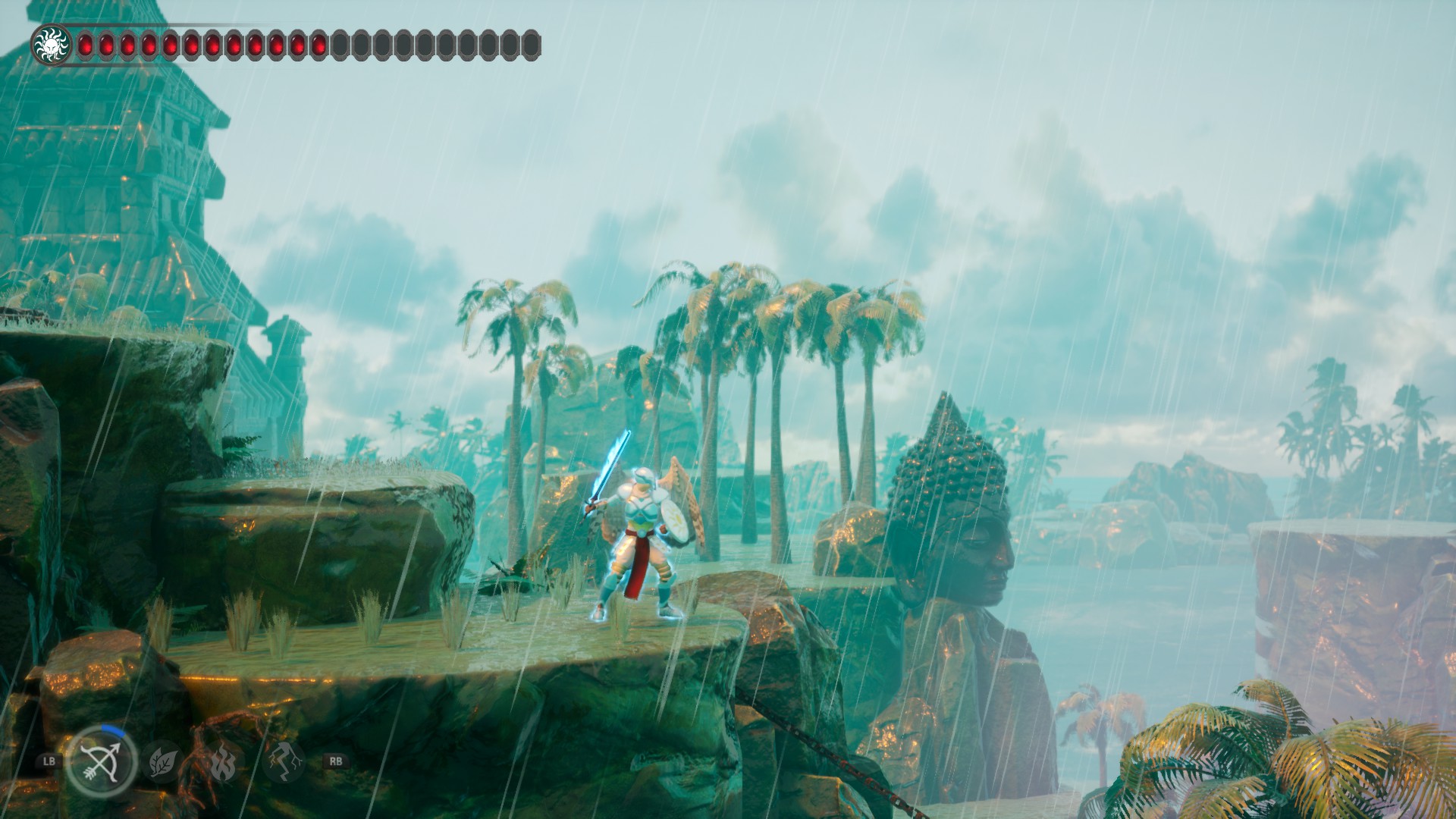A spiritual successor to ActRaiser that is too true to it in its mechanics. Needs significantly more time in the back-burner to shine.
Type: Single-player
Genre: Action, Platformer,
Tower Defense, Mythology
Developer: ACE Team
Publisher: SEGA
Release date: 10 July, 2019


Intro
SolSeraph is a spiritual successor to the SNES game ActRaiser, developed by ACE Team, the people behind the strange and great Zeno Clash series.
Although they are not consistently good, they are consistently interesting to warrant a look whenever they release a new game. My excitement grew when I learned that they had paired up with Jonas Kyratzes (one of my personal favorites!) for the game’s writing.
Unfortunately, while it has some good aspects, SolSeraph is a bit too much like ActRaiser, and definitely needed more time in the back-burner to be a truly good game.
What the game is
For those unfamiliar with ActRaiser, it was a platformer and city-builder hybrid released in 1990, on the SNES. You played the role of a deity helping human settlements to survive and flourish in hostile land. You would clear monster lairs in the platforming sections and keep the monsters at bay during the city-building sections. You could also choose the direction in which the towns were built, but that was about all the control you had. It was an extremely simple game, but it had a lot of charm, especially in the flavorful (if rather inconsequential) way you interacted with your worshipers.
SolSeraph takes the same idea, but it develops the city-building sections further. This time around, the people don’t build the towns themselves. It is also more of a tower defense game, with a simple resource gathering element coupled on to it. You need to gather wood to build, and you need food to support houses to support your defensive towers. Enemies come in increasingly harder waves from several lairs distributed in the map. Your job is to gather enough souls from the enemies to dispel the dark clouds surrounding these lairs and destroying them. Once you destroy all the lairs, you unlock the final level for the region. There are 5 regions, which can be tackled in any order.
Clearing lairs can take two forms: either a small arena level in which you defeat three waves of enemies, or a more traditional level with a boss fight at the end. The 2D action platforming is also very simple: you have a three attack combo, a backwards dodge, and a double jump. You can also swing your sword once in the air (yes, once), and acquire a few special powers from boss fights.
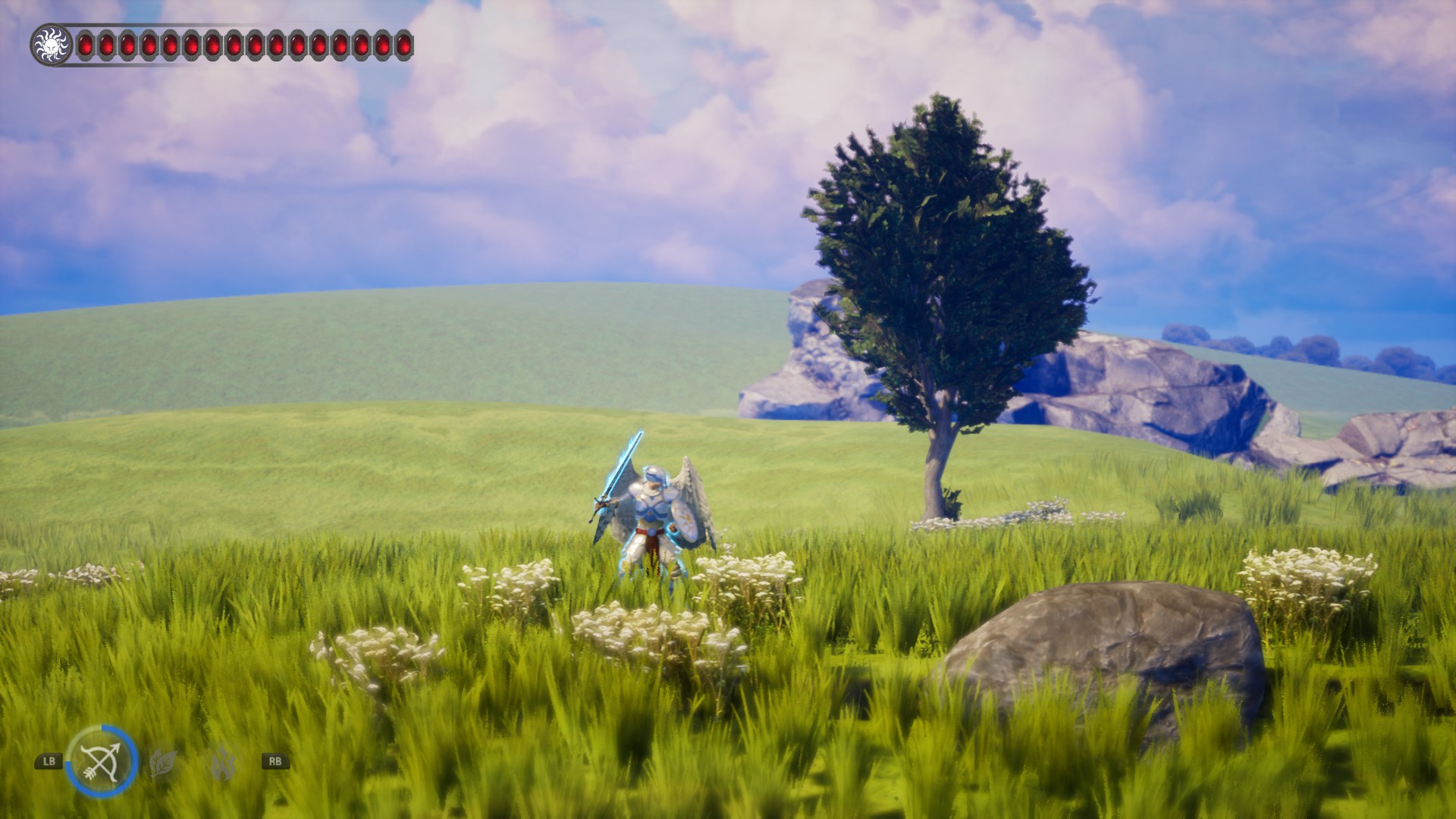
Graphics
I typically prefer sprite based platformers than 3D ones. And while this game confirms that preference with its ambiguous background-foreground elements, each zone is very distinct and, honestly, quite beautiful! The backgrounds look really great and evocative. The enemies also look good, but less distinctive. They seem a bunch of random mythological creatures (which I’ll write about later).
One aspect I must commend them for is the architecture! Not only is it good looking, it isn’t Greek – not sure if “in spite of” or “despite” having a Greek writer in the game. Too many games use the stereotypical Greek/Roman ruins indiscriminately to represent “ruined civilization”.
The architecture here looks like “less intricate Indian” – a feeling that was confirmed when I encountered the Buddha head in the screenshot. I feel like they should have kept the influences less specific, but maybe I’ve missed a theme, here. The buildings have their own style, suggesting a different world (P.S.: One of the developers confirmed that the architecture was indeed fictional, and merely inspired by ancient civilizations). The Buddha head, however, creates an inevitable connection with the “real world”, with implications that may not be intended by the developers.
Action Platforming – Clearing Lairs
The arena levels are easy and short, so I will not write about them. They are not good, but since they’re such a small element, they didn’t pain me too much. These reward you with a health or mana upgrade at the end. You need to clear every lair, and you don’t know which upgrade you’ll get before you enter the lair, so there isn’t any strategy or choice, here.
The normal levels, however, can be annoying. There are several problems.
To start off (not unlike their game Abyss Odyssey) the controls feel clunky. The reason for this is that you can’t cancel animations. Jumping is also close to Castlevania style, preventing you from adjusting where you fall after you jump. Combined with the knockback from enemy contact, the platforming can be extremely annoying. You can get used to these controls, but it still doesn’t feel particularly good, especially in the later, more difficult, levels.
Then, the game being in 3D, has enemies come from the foreground and background into the 2D lane. But it’s not at all clear when they’ve reached the lane, or when they’re going to jump into in advance, which results in swings that don’t connect and a lot of unexpected damage. To make matters worse, the enemy placement is deliberately unfair. There are tons of spiders that drop from above to which you can’t react, archers shooting from nearly offscreen, blind drops into enemies or spikes, etc. etc.; there are even environmental elements sometimes hiding enemies and other traps. This is simply not good design.
Fortunately, the levels aren’t very long, and the longer ones also have a checkpoint. These levels will sometimes have an alternative path where you can find a “Weather mana upgrade”, which extends your mana bar during the city building elements. One annoying aspect is that you don’t know which way is the “main” way and which leads to the upgrade – it has occurred to me once (at least), that I chose the wrong way, followed by a one-way drop that forced me to restart the level to get the upgrade. Oh well.
Then comes the boss. For the most part, they are very easy. Once you learn the pattern (each boss has two or three attacks at most), you can easily defeat them without too much trouble. However, you may reach the bosses without health and mana, which makes the fights more troublesome. You have some pots with health and mana throughout the levels, but you definitely reach the bosses with at least some cuts and bruises already. If you die, you go back to the checkpoint, or the beginning of the level if there was none. Old school.
The humanoid bosses are extremely easy, as you only need to attack them and then dodge once they appear to attack. Other bosses must be looked at on a case by case basis. One boss in particular was extremely frustrating: the queen of ice. This was an owl that you fought on moving platforms with spikes on the floor. Not only that, but she spent half the time out of range of your attacks. This is a terrible fight, but also the only one to provide any real challenge.
Overall, there is nothing very interesting about these platforming sections. The powers you have aren’t very important either. Healing was handy, and so was the bow and arrow, but the other powers seemed mostly useless.
The sections were passable, but not very fun (or interesting).
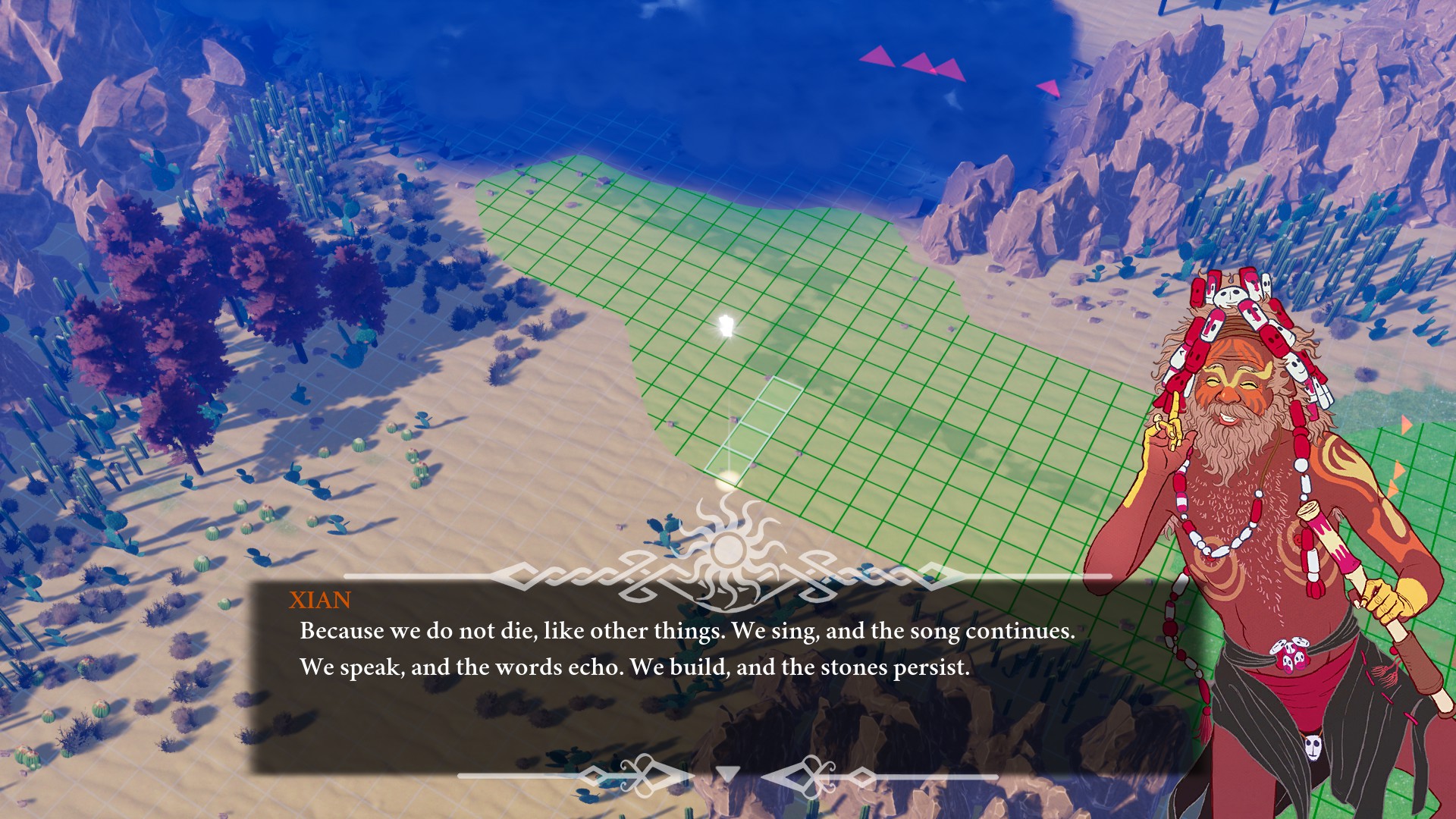
Tower Defense – Growing settlements
This is the better, but also most problematic, part of the game. The design had clearly unsolved problems, and most of the elements didn’t fit together nicely. It also reflects how the game’s writing was “added on top” rather than made an integral part of the game, which I’ll write about in the next section.
Essentially, this is a tower defense game. You can only build near other buildings, or near a road. The first problem is that roads cost nothing to build, other than some time (which is still very short), and doesn’t incur a cost on other buildings at all. So you can just setup the roads at the start and never have to worry about it. This also gives you access to trees far away from the base. Enemies walk on predefined paths and don’t attack any buildings, effectively.
The second problem is how the levels progress. I expected to carve a safe haven for a town to flourish, and to hold the town against enemies. What I got, instead, was a race. And, once you realize it is a race, it is a very easy race. Your objective, instead, is to kill the boss in a platforming level. To unlock this level, you need to destroy every lair. So the game is simply a race to destroy every lair before the waves get difficult. Because you need to collect souls from enemies before you can open the lairs, there is a lower boundary to the difficulty; but it still isn’t very difficult, and it’s easy to fight only the necessary waves before reaching the boss.
There are some problems, here:
(1) Destroying lairs doesn’t change the city-building section at all. The enemies keep spawning from that lair. Lairs are essentially “keys” to unlock the boss of each region. This is a recognized problem by the developer, but still an unsolved problem. Sure, the game would become too easy if enemies stopped spawning – but the game is still too easy. That aside, you could still associate a modifier of some sort to each lair. Maybe some tower combinations dealt with modifiers differently. Then, at least, you could tackle each lair somewhat strategically depending on your preferred towers, etc.; I don’t claim to have all the solutions (nor that they are easy!) but it’s evidence that the game needed more time in development.
(2) All the towers (including “buff” towers) occupy the same area, which is very large and doesn’t lead synergies since the play area is too small. Instead of playing around with different tower combinations, you can simply spam basic archer towers and occasionally a warrior barracks to slow enemies down. Most of the towers are completely useless. You’ll want archers adjacent to the roads, and you don’t have much room to put buffing towers. So this whole section of the game just doesn’t work.
(3) You are encouraged to deforest every region. Trees do not regenerate, and the best strategy is to simply chop down every tree immediately. You can destroy buildings and get the lumber back, so acquiring every piece of it as soon as possible is both easy and the soundest strategy. This is a big problem to me, especially in relation to the writing in the game.
(4) Each region is completely self-contained, and doesn’t change much. In the desert, you get a well to fertilize the soil, and in the snow you raise cattle instead of farming. But those are too minor to make any real difference. More importantly, once you finish a region, nothing matters anymore. You can destroy every building and there is no consequence or response. Nothing. So, really, you’re going to each region, beating the boss, and then moving on. The towns don’t develop anymore, there’s really nothing going on.
(5) Finally, there isn’t any strategy. There are no choices to be made. You can tackle regions in any order you want, but the choice is irrelevant. Even within regions, the lair order is also irrelevant. It would be great, and way more epic, if each lair had a specific upgrade which would greatly help you to thrive in another region, or even give you a new kind of tower, etc. etc.; but there’s nothing. As it stands, this section is too bare-bones, both mechanically and narratively.
Which leads to the writing in the game.
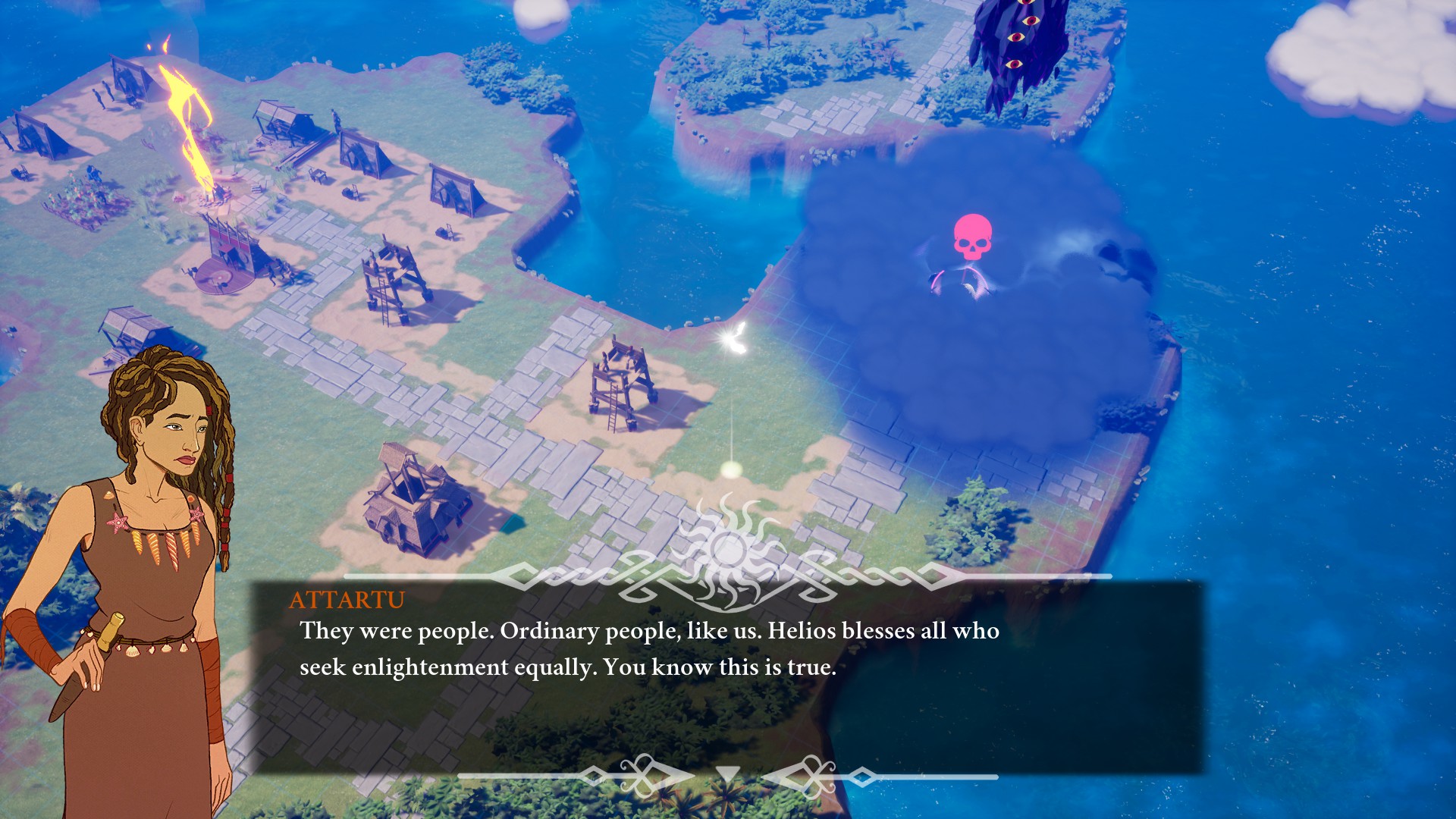
Writing
This is probably my favorite aspect of the game. But it’s unfortunate that I have to write about it separately – because it *is* a separate element.
If you’ve played Jonas Kyratzes’ other games, you can expect a similar vibe, here. The game is very hopeful, but not naively so. It’s about people taking matters into their own hands and carving out a better world out of necessity. Yet also about the loss and the unknowable mistakes of long lost civilizations.
The old world is falling apart, old leaders and authorities losing powers, and these people on the verge of falling to despair and superstition.
Each region will have its own problems and solutions, but they all share the human will to make things better. Yet it’s not all serious and there is humor in it most of the time. It’s genuinely good!
There are, however, some problems which, as I alluded to at the start of this section, stem from how shallowly the writing relates to the mechanics.
There is a very nice line about “dragon eggs hatching, and they burned and burned until nothing was left and they all starved and it was very sad” (paraphrasing, Kyratzes is a better wordsmith than I am!). But then, at the same time, you have indiscriminate deforestation in the actual game mechanics. These seem to be very much at odds with each other.
Another aspect is how there is a strong theme about “shedding off superstition” (though not faith or spirituality), and the humans taking matters into their own hands (and only then being able to reap the benefits of whatever divine intervention you provide) – but the humans do absolutely NOTHING, mechanically! It’s even a step backwards from ActRaiser. There, you merely shot monsters down in a top-down shooter while the humans built the towns themselves. Here, you’re the one who builds not only the defenses but the houses and farms as well. So, again, there seems to be a strong conflict, here, between the writing and the mechanics. I suppose this originates from both the short development time/small team involved, and the big separation between the Chilean studio and the writer living in Europe.
Finally, and this is mostly a point of misunderstanding than criticism, each region seems to be geographically unique (and suggesting different challenges as well, mechanically and narratively), but they are inhabited by a jumble of people and cultures, entirely unrelated to this geographical niche. The enemies, too, mostly fit the geography. But not the people. And it feels rather unnatural, honestly. Not sure if this is attributable to the writing or the art direction. Each character feels very unique in temperament and style, but at the same time seem to lack coherence. Why do you have a Norse leader and an Asian shaman in the Sekh(met) desert? And dark skinned people living in the snowy Vale of Yeg? Maybe I’ve missed something, here, maybe it’s the current diversity politics? There is a suggestion in the story that some kind of diaspora happened (in the relationship between two characters which I will not go into), but it isn’t sufficiently strong to justify the jumble that the game presents.
The point, ultimately, is that it seems both unnatural and unexplained, and at odds with the rest of the game world – at least that is how it felt to me.
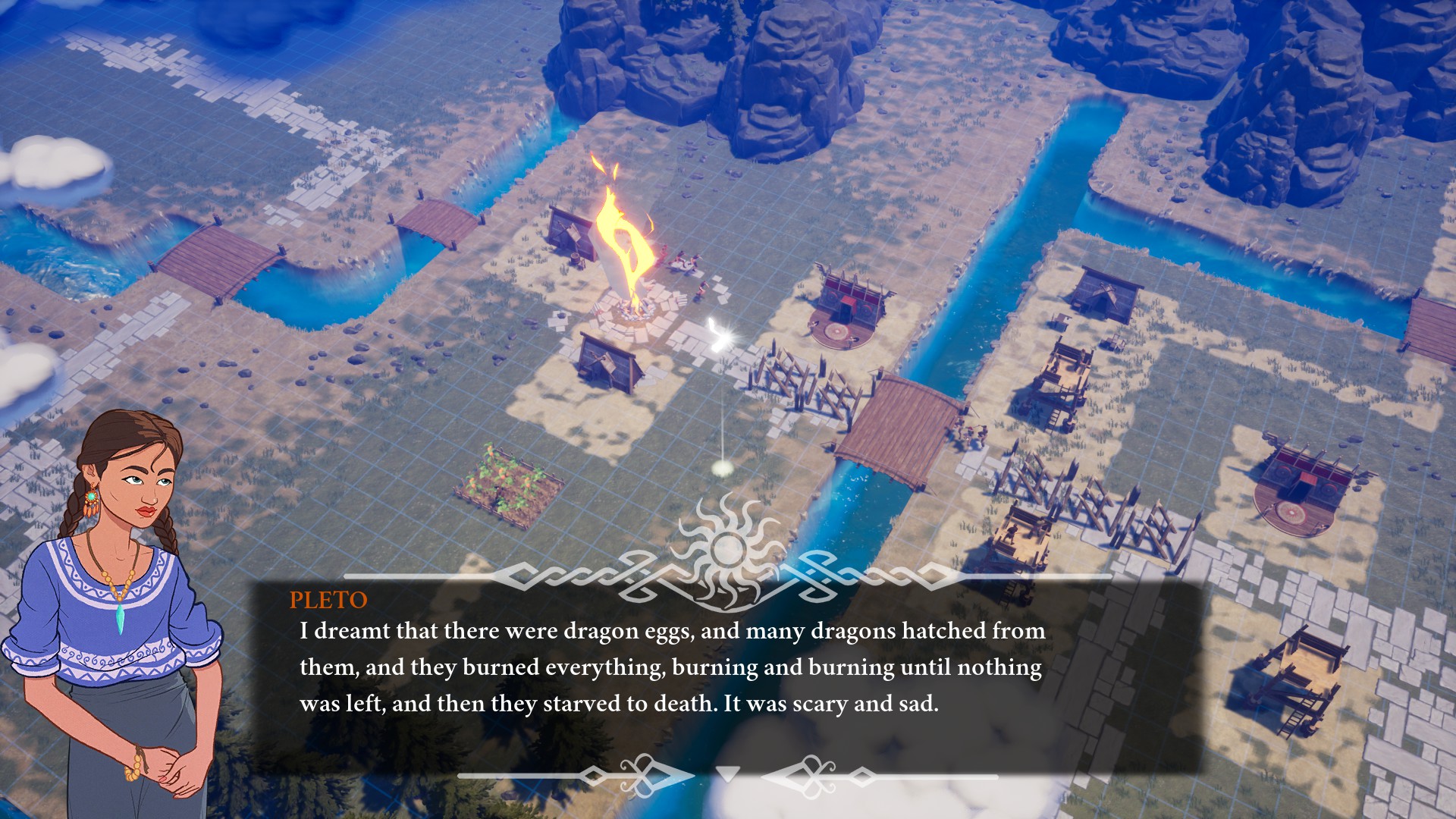
ActRaiser
Finally, I think a review of SolSeraph warrants some remarks about how it compares to ActRaiser, since this spiritual succession seems to be one of the main reasons why people are playing it.
Honestly, I find it a bit TOO MUCH like ActRaiser. In its mechanic simplicity especially. Sure, the city-building components are very different, but are similarly straightforward. The action platforming sections are short and simple as well.
Where the two differ the most, I feel, is the interaction with the humans. While the writing develops the theme much more in SolSeraph, the mechanics lost most of the flavorful interactions between worshiper and worshiped.
I don’t think those interactions were deep in ActRaiser at all, but they were there. Unfortunately, the developers here seem to have decided that shallow flavor had little value and done away with it.
Ideally, a spiritual successor to ActRaiser would have taken its shallow flavor and deeply infused its mechanics with it, beyond developing the mechanics with our modern experience. In the end, we got an okay game that contained most of the appeal of ActRaiser, but offering little more to new players unaffected by nostalgia.
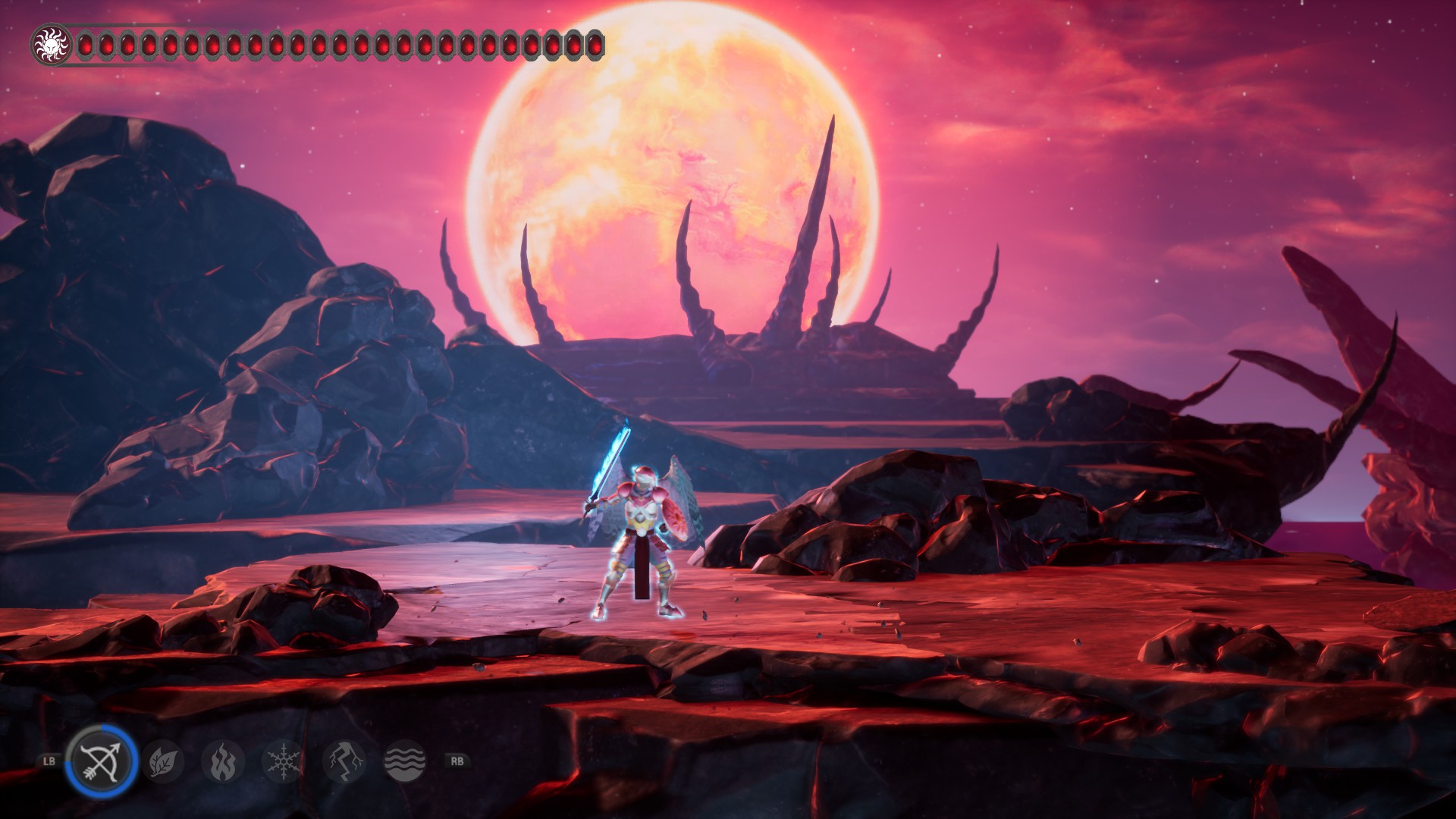
Verdict
I may have seemed harsh on the game. Part of it was because I am a big fan of both ACE Team and Jonas Kyratzes, and saw a lot of potential in a modern ActRaiser game. Unfortunately, the game seems too shy, and hasn’t gone much beyond ActRaiser. The writing is genuinely good, although the game design leaves a lot to be desired.
Fans of ACE Team and Jonas will probably be interested in playing this game regardless of what any reviews say, and to them I say go ahead! Similarly, ActRaiser fans may enjoy the similarity between the two games.
Unfortunately, it adds very little to the games already out there.


